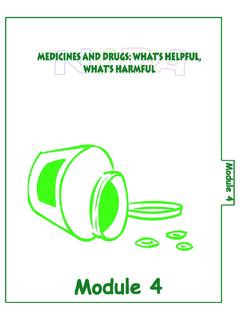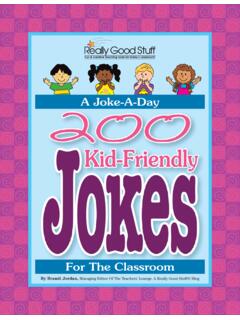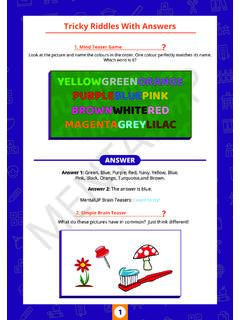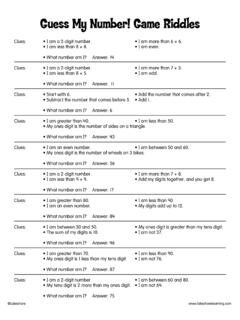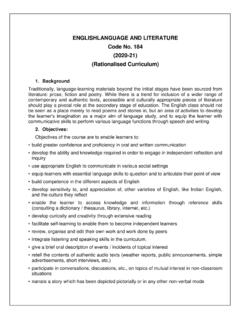Transcription of Developing a Positive Classroom Climate - ed
1 Developing a Positive Classroom Climate IDEA Paper #61 October 2016. Jason J. Barr The IDEA Center Abstract Classroom Climate is a broad construct, made up of students' feelings about their instructor and peers. Although there is a plethora of research on the effects of Classroom Climate on student outcomes at the secondary level, there is a relative dearth of such research on the postsecondary level. However, much of the research that does exist shows that students' perceptions of Classroom Climate at the postsecondary level have a great impact on learning, motivation, satisfaction, and achievement. This paper will thus provide strategies to help instructors promote Positive interpersonal relationships in the Classroom , which increases student connectedness, thereby improving Classroom Climate . Instructors should always consider how their behaviors may be interpreted by their students and keep the Classroom Climate in mind when Developing courses and lesson plans.
2 Doing so is likely to increase Positive outcomes for students as well as levels of satisfaction for the instructor. Although the goal of any higher education instructor is to class peers, and their involvement in the class. Although encourage students to learn, learning involves more than each student will develop his or her individual sense of just being exposed to information. The higher education the Classroom environment, there is also a community, or Classroom is a multidimensional environment comprising collective, sense among the students and the instructor, so psychological and social interactions among a diverse the Classroom Climate is a general feeling shared by all in academic community. Moos (1979) concluded that the the class (Fraser & Treagust, 1986). Students' perceptions social-ecological setting in which students function can affect often define the Classroom Climate because their exposure to their attitudes and moods, their behavior and performance, multiple learning environments and their many opportunities their self-concept and general sense of well-being (p.)
3 3). The to form impressions give them a credible vantage point social-ecological setting of the Classroom , often referred to from which to make judgments (Fraser & Treagust, 1986). as Classroom Climate , encompasses its social and emotional Some researchers have attempted to define and measure aspects. According to Norton (2008), the association Classroom Climate in higher education. For example, Fraser between Classroom Climate and students' academic and Treagust developed the College and University Classroom performance has been well researched. Classroom Climate Environment Inventory (CUCEI) to assess students' and is also the best predictor of students' overall satisfaction instructors' perceptions of actual and preferred Classroom with their college (Graham & Gisi, 2000). Instructors help environments. Administration of the 49-item CUCEI to 372. develop the Classroom Climate and can engage in several students and 20 instructors in 34 classes found seven interpersonal behaviors that contribute to a Positive one internally consistent dimensions of the higher education (Frisby, Berger, Burchett, Herovic, & Strawser, 2014); Classroom Climate : specifically, those behaviors that build a strong rapport with students.
4 Good rapport between instructors and students Personalization. The instructor provides opportunities for is essential to a Positive Classroom Climate and leads to student-to-teacher interaction and expresses concern for better student outcomes. Therefore, the goal of this paper is students' welfare. to provide instructors with strategies that promote Positive Involvement. The instructor encourages active student interpersonal relationships in the Classroom while also participation in class. focusing on instructional practices. Student cohesiveness. Students know one another, help one another, and are friendly toward one another. What Is Classroom Climate ? Satisfaction. Students enjoy class. The Classroom Climate is a reflection of students' opinions Task orientation. Class activities are clear and well of their academic experience (Reid & Radhakrishnan, organized. 2003). This includes students' perceptions of the rigor Innovation. The instructor utilizes unique teaching of the class, their interactions with their instructor and methods, activities, or assignments.
5 Individualization. Students are permitted to make characteristic of any successful instructor (Catt, Miller, &. decisions and treated differentially based upon ability Schallenkamp, 2007). Teaching is a rapport-intensive field and interests. (Jorgenson, 1992) where both instructor and students enter the Classroom with relational goals (Frymier, 2007). Rapport When creating the CUCEI, Fraser and Treagust found that five is built and a Positive Classroom Climate is developed when of the seven dimensions of Classroom Climate involvement, instructors and students coconstruct a learning environment personalization, student cohesiveness, task orientation, and that encourages active student participation (Sidelinger &. individualization were positively correlated with student Booth-Butterfield, 2010). The development of rapport and overall class satisfaction. a Positive Classroom Climate has been linked to Positive student outcomes, such as promoting student motivation Similarly, Winston, Vahala, Nichols, Gillis, and Rome (1994) and diminishing student apprehension (Ellis, 2004).
6 Engaging developed the College Classroom Environment Scales. Factor in rapport-building behaviors has been shown to positively analysis of the original 143 items yielded a 52-item scale influence students' opinions of instructor credibility and with 6 factors: students' evaluations of instruction (Schrodt, Turman, & Soliz, 2006). For example, using the Professor-Student Rapport Cathectic learning Climate . An environment that Scale (Wilson, Ryan, & Pugh, 2010), instructor rapport stimulates students to be active participants. was found to account for 54% of the variance in end-of- Professorial concern. Students perceive the instructor as semester student ratings of instruction (Richmond, Berglund, personally concerned about them as individuals. Epelbaum, & Kelin, 2015). Additionally, Richmond et al. found Inimical ambiance. Students view the environment as that students' self-reported course engagement and their hostile, competitive, and rigid.
7 Perceptions of professor humor added only 4% and 1% of Academic rigor. An environment that is intellectually variance respectively to end-of-semester student ratings of challenging and demanding. instruction. Instructors should remember that communication Affiliation. The environment promotes informal interaction with their students is both interpersonal as well as content- that is highly supportive, friendly, and student-centered. driven (Frymier & Houser, 2000), meaning that instructors Structure. Students see evaluation criteria and course not only influence what students learn but play a crucial content clearly articulated. role in Developing rapport and a Positive Classroom Climate . Students who rate their instructors high in rapport also report Fraser and Treagust (1986) and Winston et al. (1994) that their instructors convey caring by expressing concern for each differ in the factors they identified that contribute how well they learn, create an atmosphere that encourages to Classroom Climate .
8 However, there is one overarching student effort and commitment, clearly communicate course similarity among all the factors: They represent those expectations, and stimulate their interest in and enthusiasm characteristics of interpersonal relationships that for the subject (Hoyt & Eun-Joo, 2002). Such rapport-building instructors can control, such as listening to and respecting communication behaviors include confirming behaviors, students, expressing interest in student ideas, encouraging which are the transactional process by which teachers participation, and offering help to students inside and outside communicate to students that they are endorsed, recognized, of the Classroom . Classroom Climate also doesn't include and acknowledged as valuable, significant individuals'' (Ellis, those aspects that instructors are not able to control such 2000, p. 266). as the physical setting of the Classroom and equipment, background of the students, and organizational structures Instructors can utilize several confirming behaviors to such as class scheduling and sequencing.
9 Frisby and Martin convey care and develop rapport (Ellis, 2000, 2004). (2010) state that the ability to develop an interpersonal First, instructors respond to questions, which verbally and relationship based on harmony, connection, and mutual nonverbally communicates interest in students' comments. trust or to develop rapport enhances the instructor- This occurs in class, during office hours, or electronically, student relationship as well as student-student relationships, demonstrating the instructors' accessibility outside of and therefore helps develop a Positive Classroom Climate . class. Instructors demonstrate interest in and communicate Classroom Climate is fundamentally interpersonal in nature, concern for students, whether regarding academic or which is why it is expressed through the perceptions of the personal matters. Such interest can be expressed toward students and demonstrated to have such a profound impact the whole class ( , Because of the low quiz grades, I.)
10 On student outcomes. The instructor can use all these want to review the material from last week to make sure it rapport-building strategies regardless of who or what they is clear before we move on) or individually ( , Your high teach. Therefore, an essential component of teaching is absenteeism is concerning because I'm afraid you won't building strong relationships with and among students. be able to complete the required assignments ). Students have reported that instructors who help build rapport Beyond Instruction: Focusing on the and communicate concern and interest do so by praising student work, actions, or participation; engaging in informal Interpersonal Aspects of Teaching conversation with students before or after class; utilizing Rapport is a feeling between two people encompassing the terms we or our class; and asking students about their a mutual, trusting, and prosocial bond, and students feelings regarding assignments (Ellis, 2000, 2004).










